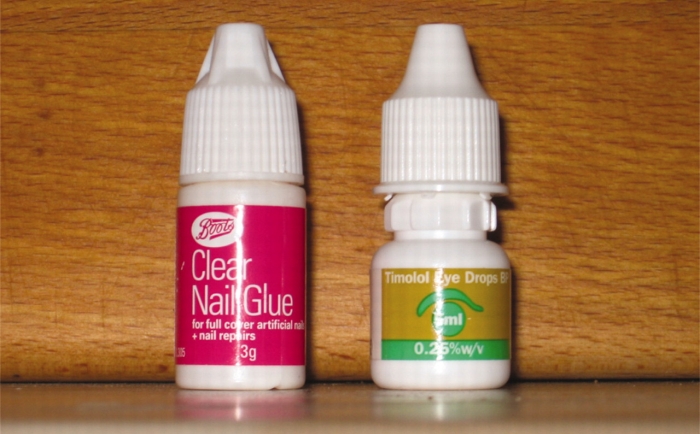Doctors in the UK called for a change in glue packaging after a 64-year-old man rocked up to hospital in a sticky situation - he'd put nail glue in his eye instead of eyedrops.
That's the super-strong, fast-acting stuff (not dissimilar to Super Glue) that is used to glue false nails on, so not particularly something you'd want in your eye.
According to the 2010 case report, he presented to Oxford Eye Hospital with blurry vision and severe pain in his left eye after trying to administer "eyedrops" two hours prior.
He had, he said, mistaken a pharmacy brand bottle of glue for the Timolol eyedrops he had been prescribed after eye surgery. And apparently, he's not the only one.
The bottles are strikingly similar in size, shape and opening mechanism, so it's easy to see how the mistake was made, even if you're not peering through a veneer of glue.
The patient in question was both clever and lucky. As soon as he realised his mistake, which was pretty much immediately, he washed his eye out with water. Even so, his eyelids were glued together, and the glue had to be very carefully removed using fine forceps, and a slit lamp for magnification.
 (Yusuf and Patel, BMJ Case Reports)
(Yusuf and Patel, BMJ Case Reports)
He was left with a moderately red eye and some abrasion on his cornea - both thankfully temporary conditions. He was given treatment, and two weeks later both his eyes were normal.
But, the doctors noted, it could have been a lot worse - and is just one example in a long line of such incidents. In fact, they say they know exactly when people started putting nail glue in their eyes.
"Inadvertent ocular cyanoacrylate or 'superglue' instillation mistaken for intraocular eye drops has been reported in the literature on several occasions since it was first described in 1982," they wrote in their paper.
And this, they believe, can be ascribed to something that happened in the early 1980s. Although cyanoacrylate nail glue had been available since the late 1950s, in the early 80s, the packaging changed - to dropper bottles. Like those eyedrops are packaged in.
"Accidental instillation of commercial cyanoacrylate results in significant short term ocular morbidities," the doctors wrote in their paper.
"Those reported include corneal abrasions, punctuate keratopathy, conjunctivitis and conjunctival abrasion, eyelid skin excoriation, loss of eyelashes, tarsorrhaphy, periocular dermatitis, invariable intense stinging or burning pain upon instillation, significant loss of visual acuity and/or functional blindness."
Changing the packaging was suggested in 1994, but had not been heeded. The doctors suggested in 2010 that a simple change to include a safety mechanism on the glue bottles would go a long way towards minimising sticky mix-ups.
When the paper was penned, there had been 36 reports of glue-related eye injury in literature. There's probably a few more added to that number since then - and many nail glue brands are indeed now using packaging that looks more like glue or nail polish.
There are still a few that look like eyedrops, though - including the Boots pharmacy brand that injured the patient. Until that changes, the doctors said, injuries will continue to occur.
The case report appears in BMJ Case Reports.
